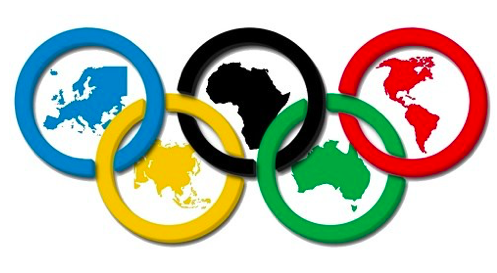
We live in a cultural climate that defines things along High School Musical-esque binaries. A world in which jocks and theatre kids don’t mix, and arts programs are always the first to be cut from budgets, while college football coaches make seven figures. Yet why should it be so? The sports section of our database has always been a valued part of Sartle, and we’re big fans of the Golden State Warriors! Can’t arts and sports just get along?
Such a union was the brainchild of Pierre de Fredy, Baron de Coubertin, founder of the International Olympics Committee. Coubertin was a visionary who conceived of the Olympics as a world cultural festival in which athletics and arts would merge to enrich body, mind and spirit. Thus, between 1912 and 1948, the Summer Olympics featured competitive art competitions spanning architecture, literature, drama, music, painting and sculpture. Here is a brief history of the Olympic Art Competitions with a few of our favorite medalists in visual arts, relics of that more idealistic time.
1912 Stockholm Olympics
The Olympic Art Competitions had been Coubertin’s pet project from the first modern Olympic Games in 1894, but 1912 was the year he finally got the organizers to sponsor the event. With world wars looming on the horizon, Coubertin felt that competitive sports and cultural events could deter people from expressing competitive urges through violence. Unfortunately, with a paltry 35 submissions, the first Olympic Art Competitions failed to make an impression.
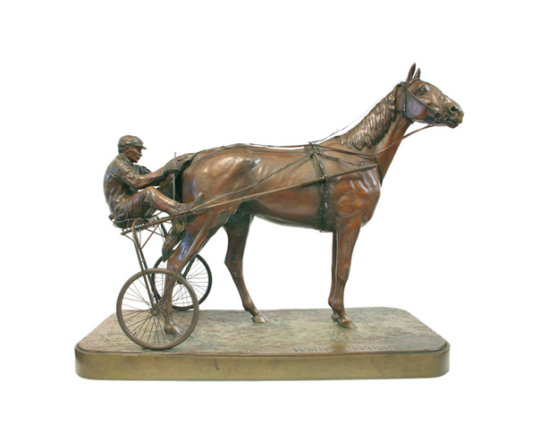
An American Trotter by Walter W. Winans (USA). Gold medal winner (mixed sculpture). Because who doesn’t love a horsey.
World War I inevitably came despite Coubertin’s best efforts, and the 1920 Olympic Art Competitions, held in the ruins of post-war Belgium, produced an equally lackluster response.
1924 Paris Olympics
1924 Paris was the year of change. The Jazz Age was heating up, the lost generation was finding its voice, and art suddenly seemed more important than ever before. Artists submitted 193 works, and the quality spiked. Jean Rene Gauguin, none other than Paul Gauguin’s son, went home with a bronze medal in sculpture (image not available).
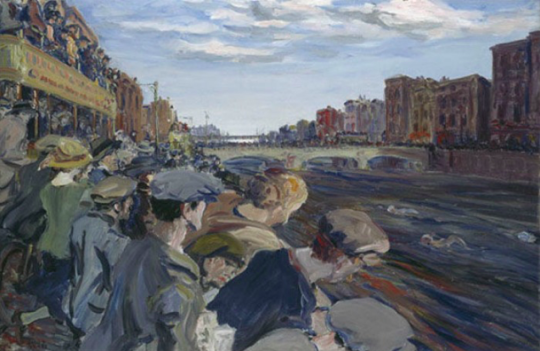
The Liffey Swim by Jack Butler Yeats (Ireland). Silver medal winner (mixed painting). Jack’s brother was the famous poet W. B. Yeats. The Manet-like quality has a real sense of movement.
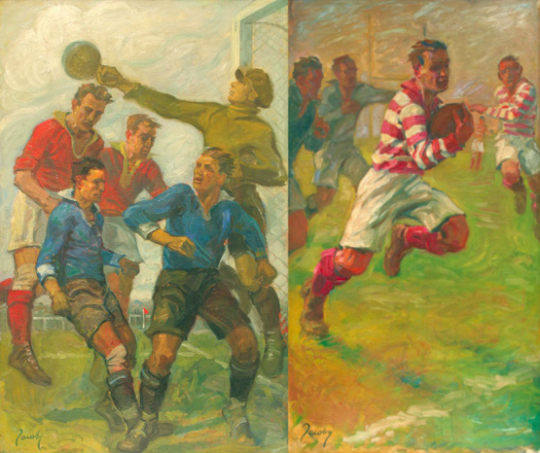
Study of Sport by Jean Jacoby (Luxembourg). Gold medal winner (mixed painting). Jean Jacoby was the only artist awarded two gold medals, making him the most successful Olympic artist of all time.
1928 Amsterdam Olympics
1928 saw the steepest spike yet, with over 1,100 works submitted in visual arts alone.
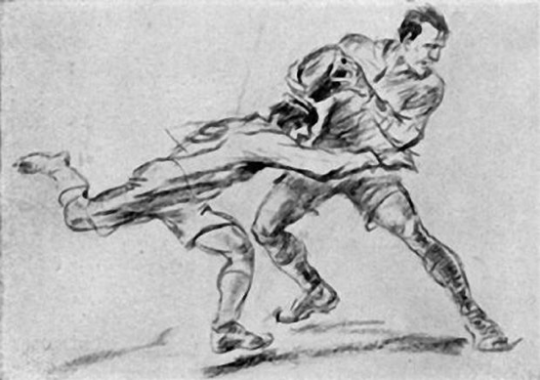
Rugby by Jean Jacoby (Luxembourg). Gold medal winner (drawing). Jean Jacoby won his second gold medal in a row for this.
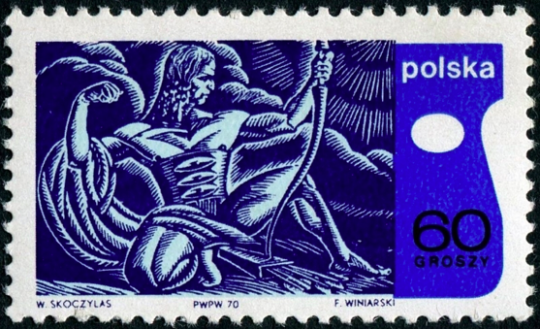
Sample of Posters by Wladyslaw Skoczylas (Poland). Bronze medal winner (drawing/watercolor). Skoczylas designed a series of graphic posters which were adapted into commemorative postage stamps like the one above.
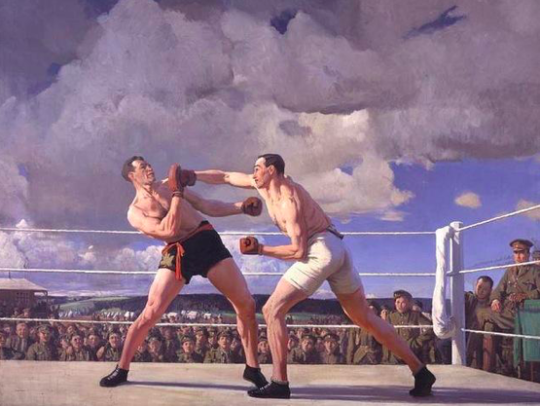
Boxeurs by Laura Knight (Great Britain). Silver medal winner (painting). Knight brings Stag at Sharkey’s to mind.
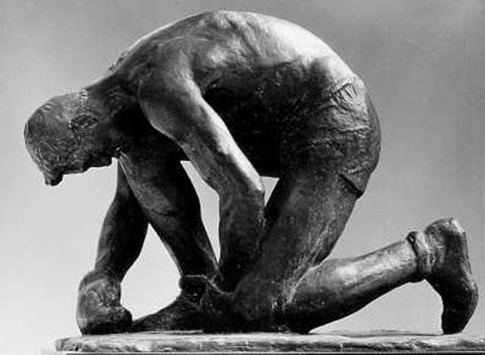
Boxer by Paul Landowski (France). Gold medal winner (statues). Boxing was a particularly popular theme throughout the Olympic Art Competitions. Landowski seems inspired by Rodin.
1932 Los Angeles Olympics
It was the height of the Great Depression, and (relative to Europe) the most remote Olympics that had ever been held. People forget that the USA was still a developing country until after World War II, and we Americans were eager to prove we were more than a rebellious poor relation of the British Empire.
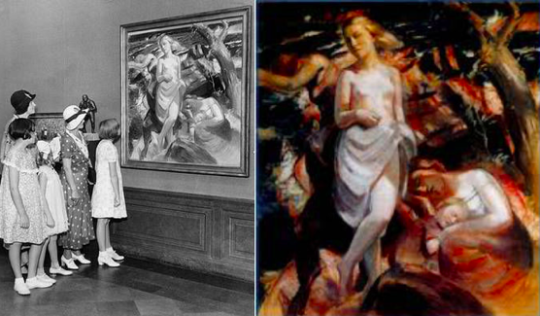
At the Seaside of Arild by David Wallin (Sweden). Gold medal winner (painting), as seen in the exhibition hall of the LA Olympics (right).
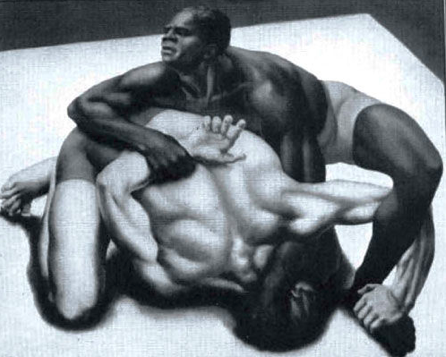
The Struggle by Ruth Miller (USA). Silver medal winner (painting). Miller invokes Diego Rivera meets Thomas Eakins. She also taps into an increasingly racially diverse Olympics, a trend that would be highly politicized four years later at the 1936 Nazi Games.
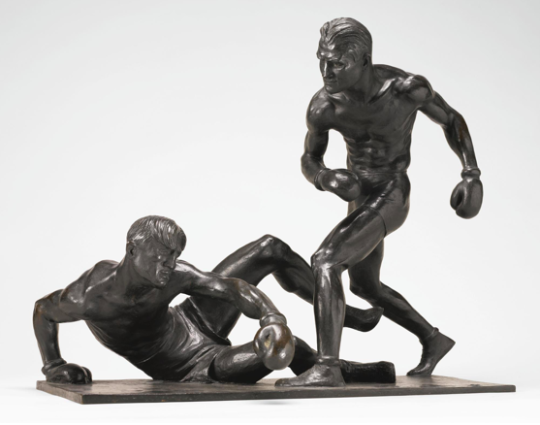
The Knockdown by Mahonri Young (USA). Gold medal winner (statue). It’s like Dempsey and Firpo in 3D!
America went home with seven art medals in all (unprecedented for a host country) with the help of some good old fashioned American rigging. 24 of the 30 judges on the panel were from the USA.
1936 Berlin Olympics
It was the year of Jesse Owens’ historic win, and pioneering female director Leni Riefenstahl’s controversial propaganda epic, Olympia. The streets had been scrubbed clean of anti semitic propaganda, and Hitler gave strict orders that “foreigners” be treated with “extreme tolerance.” In other words, “everyone pretend not to be racist until the tourists go home.” Art was a state-controlled propaganda tool in Nazi Germany, so 1936 was Hitler’s year to prove his dogma of Aryan supremacy in both athletic and cultural fields.
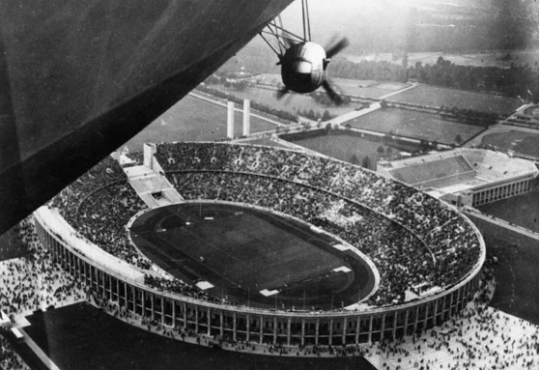
Reich Sport Field by Werner March (German Third Reich). Gold medal winner (municipal planning), silver medal winner (architecture). View of March’s Olympic Stadium from the Hindenburg, just months before the airship exploded killing 36 people.
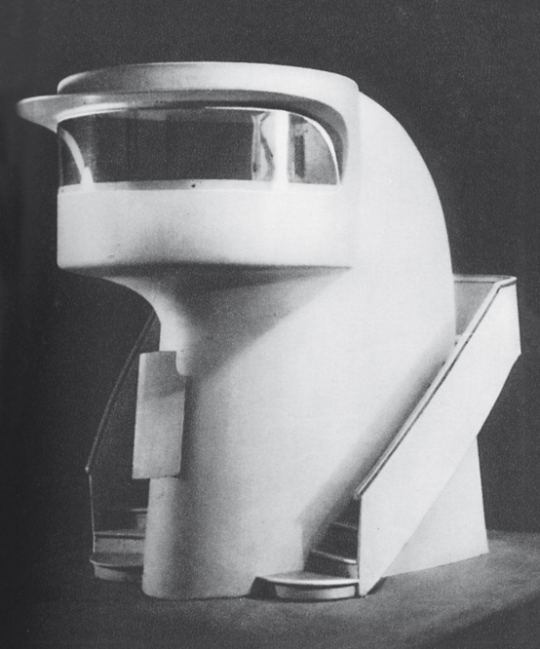
Model of a timekeeping pavilion by Guglielmo Giuliano (Fascist Italy). Submission (architecture). Though this design didn’t win, it reflects the futurist, sleek yet inhuman aesthetic prized by fascist regimes.
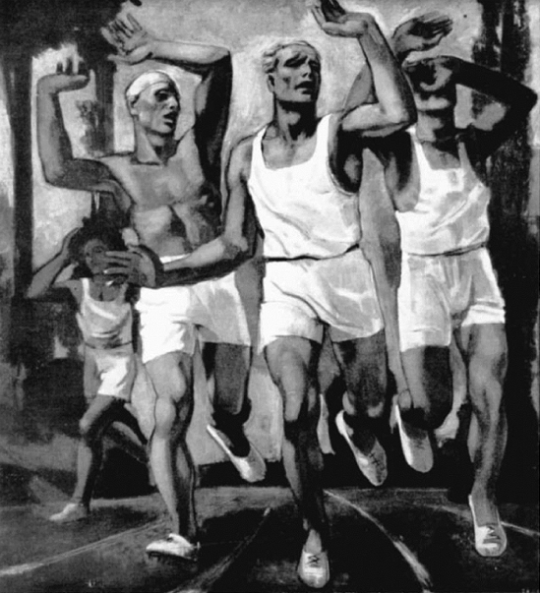
Runner at the Finishing Line by Rudolf Eisenmenger (Austria). Silver medal winner (painting).
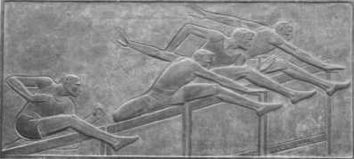
Hurdlers by Emil Sutor (German Third Reich). Gold medal winner (reliefs).
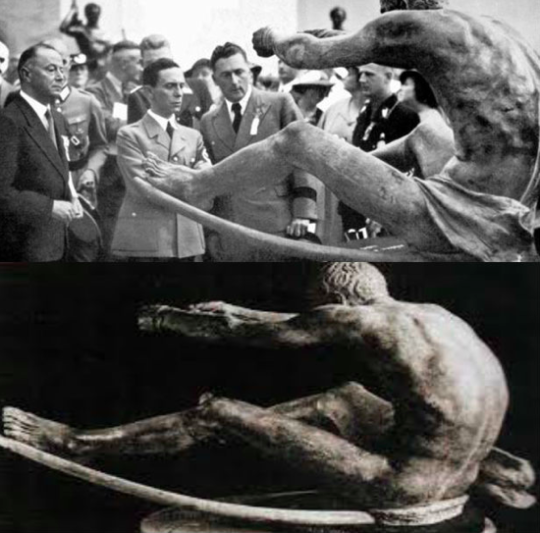
Sulky Driver by Farpi Vignoli (Fascist Italy). Gold medal winner (statues). Minister of Propaganda Joseph Goebbels inspects the statue during the exhibition (top).
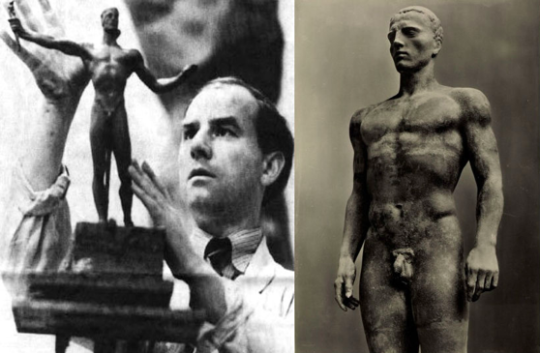
Decathlon Athlete by Arno Breker (German Third Reich). Silver medal winner (statues).
Arno Breker was an official sculptor of the Third Reich. The Nazis abhorred homosexuality, but seemed artistically obsessed with hyper-masculinized, homoerotic imagery. As one observer commented on a 1938 Nazi-sponsored art exhibition, “I could hardly believe my eyes. The trend is eroticism…a 3-day art orgy.”
To ensure victory, the Nazis took a page out of America’s playbook, with 29 German judges on the panel out of 41. It is hardly surprising that Nazi Germany took home a whopping 12 medals, with Fascist Italy in second place, and Austria (Hitler’s birth-country) in third.
1940 Tokyo Olympics: The year that got away
The 1940 Tokyo Olympics were postponed indefinitely because of the outbreak of a minor inconvenience known as World War II. The possibilities of back-to-back Olympics in the capitals of the Axis powers are mouthwatering to the speculative historians among us. It would also have been the first Olympics hosted by an Asian city, and given the Japanese flair for design, the artistic potential is intriguing.

These unused publicity materials for the 1940 Tokyo Olympics hint at the graphic possibilities of what would have been the first and only non-Eurocentric Olympic Art Competitions.
It would also have been the year future film star Esther Williams swam for the Olympic team.
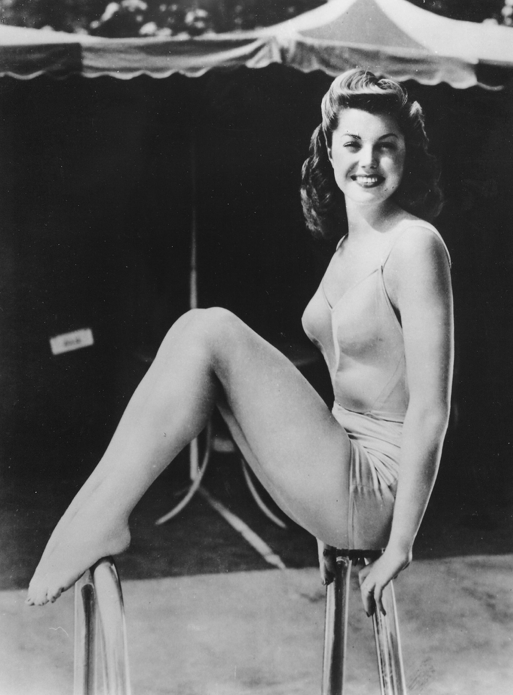
If you’re wondering why this is relevant, I just wanted an excuse to post a picture of Esther Williams in a swimsuit…I regret nothing!
1948 London Olympics
The World Wars were behind us, and it seemed somehow appropriate to host the first Games (since the infamous Nazi Olympics of ‘36) in London; the city that had endured nightly bombing raids for half a decade and still kept calm and carried on. It was a new dawn for mankind, and the artistic submissions were some of the most striking and original to date.
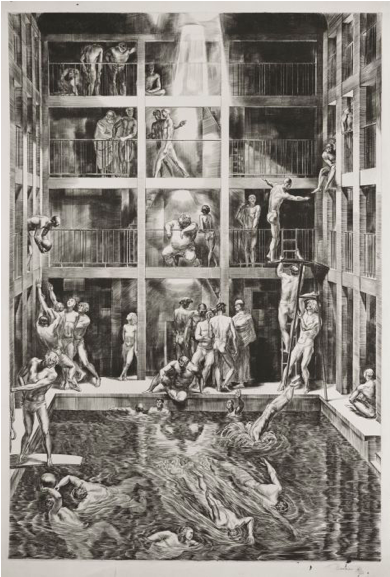
Swimming Pool by Albert Decaris (France). Gold medal winner (engravings and etchings). This has a Reginald Marsh-esque chaotic energy, and frenzied composition.
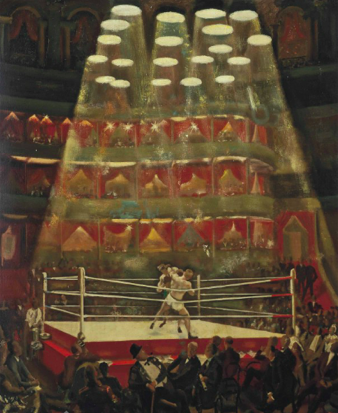
London Amateur Championships by Alfred Thomas (Great Britain). Gold medal winner (painting). George Bellows and the ashcan painters come to mind.
Sadly, 1948 would also be the last official year of competitive arts in the Olympics. With the notable exceptions of the politically charged 1932 and 1936 Games, the Olympic Art Competitions failed to have the cultural impact Baron de Coubertin had hoped for.
At that time, participating athletes and artists were expected to be amateurs. In consequence, the bar on professional artists often led to a sub-par quality of work. Furthermore, medals were awarded solely on merit, meaning there weren’t always medalists in every category every year. The cultural powers that be finally lost interest in Coubertin’s noble experiment. Tellingly, the Olympics Committee eventually made concessions for professional athletes to compete, but neglected to lift the ban on artists.
But like a Bernie or Bust supporter clinging to the last piece of wreckage of a ship that has long since been sunk by the establishment, the artistic movement started by Coubertin lives on in spite of Committee skepticism. Since 1952, the Olympic Cultural Programme has continued to sponsor artistic events.
The 2016 Rio de Janeiro Olympic Games are (shockingly) the first ever hosted by a South American city, and in this revolutionary spirit, artistic innovation still triumphs.
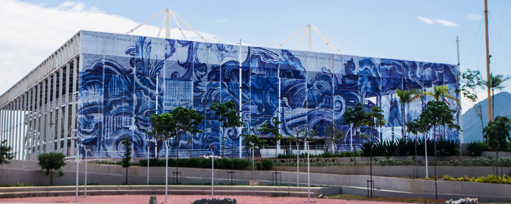
Untitled mural from the Rio 2016 Olympic swimming pavilion by Adriana Varejao (Brazil).
For this groundbreaking work of public art for the 2016 Olympics, Varejao creates a seemingly innocuous waterscape. The mural (the largest work of art created for the Rio Olympics) is a neo-baroque masterpiece which has raised eyebrows by asking complicated questions about Brazil’s colonial past. The semi-abstract, blue and white waves recall pleasant days at the beach for many. But for black, mix-raced and indegenous Brazilians, the deceptively passive imagery of water and baroque flourishes can have associations with the dreaded middle-passage of the Atlantic slave trade, and the legacy of Portuguese colonialism.
Thus, Adriana Varejao brings the spirit of the long-dead Olympic Art Competitions into a new era, creating controversial art for a modern, post-colonial context. The sports/art revolution lives on!

Originally posted by Election 2016.
By: Griff Stecyk










The Olympics need a hard reformat. It's the biggest, scammiest money grab.